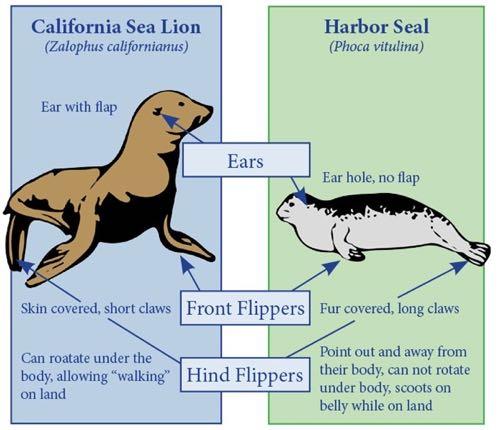A very common question is: What is the difference between a seal and a sea lion. Looking at the chart below, you can see three differences.
 Seal comparison to Sea Lion Chart
Seal comparison to Sea Lion Chart
Photo Credit: National Park Service
Personally when I look at a seal and a sea lion it is easiest for me to tell the difference when they are moving; seals look like they are pulling themselves along and sea lions look like they are walking on their front flippers with a little waddle.
The map below illustrates the location of seals and sea lions around the world. Yellow is seals, red is sea lions, and purple is where they both can be found. Living in Massachusetts we only have seals in our ocean waters. The ocean off the coast of California, where most of the other research team is from, has both seals and sea lions.
 Map of seal and sea lion population distribution
Map of seal and sea lion population distribution
Photo Credit: National Marine Life Center
Seals and Sea Lions are not even members of the same family! Taxonomy is the branch of science that classifies organisms by the following system: Kingdom, Phylum, Class, Order, Family, Genus, and Species. You may have heard a mnemonic that helps people remember the levels of taxonomy: King Phillip Came Over From Great Spain, Keep Placing Cake Orders For Good Students, or maybe you created your own.
Seals and sea lions share the following classifications: Kingdom: Animalia – Multi-cellular and heterotrophs Phylum: Chordata – Has a central nervous system (spinal cord) Class: Mammalia- Warm-blooded, have hair and mammary glands Order: Carnivora – Carnivores Class: Pinnipedia – Have 4 webbed flippers and are adapted to function in both air and water
Seals and Sea lions differ at Family level. Seals are Family Phocidae [FOE-sih-day],, lack an external ear, and sea lions are Family Otariidae [Oh-tah-RYE-ih-day], have an external ear. Genus and species continue to branch in each sub-family based on evolution.
What about the fur seal? Take a look at the picture below; is the fur seal a seal or a sea lion?
 Fur Seal
Fur Seal
Photo Credit: Wilderness Classroom Educational Adventures
Look at those external ears!!! The fur seal is actually a sea lion.
The map above does not include information about where fur seals live in the world. Fur seals can be found in Antarctica and North in the frigid waters of the Bering Sea. The map below includes the distribution of the nine fur seal species found in the world.
 Fur Seal Range Map
Fur Seal Range Map
 Fur Seal Map Key
Fur Seal Map Key
Photo Credit: Craig Pemberton [CC BY-SA 3.0 (https://creativecommons.org/licenses/by-sa/3.0)]
What makes fur seal different from other sea lions that allow them to live in these extreme cold temperatures?
In the photograph below are sculps (fur, skin, and blubber) samples. The sample to the left was collected from a fur seal and the sample to the right was collected from a sea lion.
 Sculps from fur seal and sea lions
Sculps from fur seal and sea lions
Photo Credit: Heather Liwanag US Department of Commerce permit #960-1528-00/PRT-017891
Dr. Heather Liwanag summarized the difference of fur seals and seal lions for me: “Fur seals have thick, waterproof fur, which they use for insulation in water. (Only river otters and sea otters have a greater fur density.) In contrast, sea lions have coarse, non-waterproof fur, and they have to rely on their blubber for insulation in water.” Can you see these differences by looking at the image above?
Did you know the walrus is also in the class pinnipedia? Investigate how the walrus is similar and different to seals and sea lions; write what you learn in the comments section below.


Comments
Add new comment